Snowshoeing is a great way to spend time outdoors in winter. Not only are snowshoes easy to use and super fun, but there are many interesting nature trails in Japan that allow you to enjoy magnificent winter scenery. The biggest challange in Japan is to know where the suitable trails for independent snowshoeing are. But don’t worry, that’s what I found out for you already. Read this guide to:
- Learn about my first experience on independent snowshoeing in Japan,
- Discover interesting trails in Nagano Prefecture;
- Prepare well for your own adventure with the practical snowshoeing tips included in this article.
And even if, after reading this guide, you still don’t feel like snowshoeing without a guide, you can try one of the snowshoeing tours, which I’ve recommended in this blog post as well.

What's in this blog post?
My first Christmas in Japan
Every year I go back to Poland to spend Christmas with my family. We have a Christmas tree and eat traditional Polish food. I finally meet my friends who I miss all year round. I usually spend New Year’s Eve with friends in the mountains in Italy. We cook delicious food, drink liters of red wine, play board games, take long walks in nature, talk and laugh until dawn.
But then 2020 happened. It turned my plans, priorities, whole life upside down. Actually, not only mine, but the entire world’. Therefore, the end of the year had to be also different than usual. It was going to be my first Christmas in Japan. I knew if I stayed in Tokyo, I would be very sad. I had to go and explore, preferably nature.


But where do you go in winter in Japan? Six years of life in the tropical climate of Singapore erased from my head a concept of cold weather, snow and short, dark days. We couldn’t go to the seaside in December, unless I wanted the wind to blow my head off. I know this feeling too well from the Baltic Sea in my Polish hometown – Gdynia. 🙂 In winter it is too cold to swim, even in the southernmost prefecture of Japan, Okinawa. At least it is too cold for me.
By the way, I visited one of the Okinawa islands – Ishigaki in August and it was awesome. Read more in “TROPICAL PARADISE IN JAPAN – ISHIGAKI ISLAND“.
The answer was easy. Actually, there was only one choice from the very beginning. If I can’t be with my loved ones over Christmas, the second-best option is a trip to the mountains. But what to do in winter in the mountains if you cannot climb the peaks and skiing is not a feasible option at the moment?
Snowshoeing.
Let's try something new! Snowshoeing in Japan
I’ve never used snowshoes before, most probably because they are not very popular in Poland. But it sounded so interesting and easy. They allow you to enjoy nature on cold and snowy days. It was exactly what I was looking for. But where to go snowshoeing in Japan?
Nagano Prefecture is famous for its many mountain ranges and beautiful landscape. 14 of Japan’s 21 highest peaks over 3,000 m are right here. When I go to the mountains, I prefer them to be high as I’ve spent too much time trekking in Nepal lately. In addition, Nagano is a great place for winter sports because of the 1998 Winter Olympics and its well-developed infrastructure. Moreover, it takes only 90 minutes from Tokyo Station to the city of Nagano by shinkansen. To conclude, the choice where to go was also easy.


Besides, Nagano is probably the only place in the world where you can watch monkeys taking a hot bath! Read more about this incredible experience in “Wild monkeys in hot springs snow monkey park“.
The only problem was that almost all the information available on the internet was about organized trips, which I don’t really enjoy. I prefer to plan everything myself. I love freedom too much to be told what to do, when to start and finish
Besides, I didn’t want to pay anyone to walk me in the forest. Many sources claim that independent snowshoeing in Japan can be dangerous. Without knowing the area, you might end up in a snow-covered pond or a frozen river. I guess that’s partly true, but… If you have a map as well as a good plan and you’re prepared, how dangerous can it be to walk through fresh snow in a tranquil forest in a developed country in fine weather? Certain precautions must of course be taken. But if you are a mountain lover and adventurer, you know you don’t really need a guide.
Probably the same online sources consider trekking without a guide in Nepal too dangerous…

How do snowshoes work? Buying vs renting
Snowshoes are easier than you think. You just put them on over any shoes, as you don’t need any special footwear, and set off into the snowy terrain. No special skills are required. Snowshoes distribute the weight of the body over a larger area, which prevents falling into the snow. I regretted not having them in the Himalayas on the Annapurna trek when I crossed the Thorong La Pass in deep snow. It would be so much easier. 🙂
Although snowshoe rental is possible in many mountain locations in Japan, and prices range between 1,000 – 2,200 JPY for a day (10 – 20 USD), I’ve decided to buy my own pair. I just think that having your own gear gives you more independence.
But I’ll be honest. When I was buying my snowshoes, I didn’t know much about the different types and models. Actually, I still don’t know much, even after my trip. I just know that mine worked pretty well as hiking in the snow was easy.
Because my snowshoe knowledge was limited and I wasn’t sure if I would enjoy hiking in snow, I decided to get the cheapest pair available on the internet for 5,500 JPY (~50 USD). My snowshoes are definitely not compact, which is probably why they cost so little. They will not be the best choice for narrow and steep trails. However, they turned out great on the easy trails described below. Check the model of my snowshoes HERE.
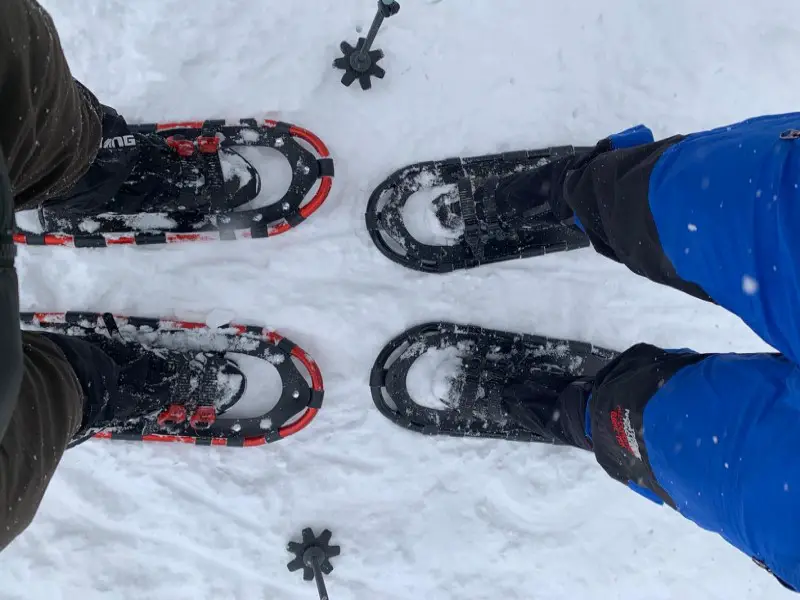
You can also check more expensive options in the links below.
Independent snowshoeing in Nagano prefecture
I spent a lot of time trying to figure out where to go snowshoeing without having to join an organized tour and hire an expensive guide. It was not easy to find information. At some point I decided to listen to my intuition and I found some nice trails.
Below you will find a description of 5 easy trails where you can try independent snowshoeing in Japan, precisely in Nagano Prefecture. Since you don’t have to search the internet anymore, you have everything you need right here. Therefore get your snowshoes fast and enjoy the famous Japanese snow before spring arrives and it melts!
Snowshoe trails in the Hakuba Valley
This is where my independent snowshoeing adventure in Japan has begun. Both trails are very good for the beginners.
Mount Iwatake
To start you snowshoeing adventure head towards Iwatake Snow Field, one of the ski resorts in the Hakuba Valley, which is very easy to reach as the ski shuttles stop right in front of it. Next, you need to get to the top of Mount Iwatake (1,290 m). This is also very pleasant and easy as you get there in gondola. On the top of the mountain you will enjoy not only a fantastic view over the Japanese Alps and the Hakuba Valley but also a special 2 km long trail for snowshoeing.


After reaching the top, you must register at the patrol station, where you will receive a simple map of the snowshoeing area. The trail through a beautiful forest is good for beginners, as the elevation difference is only 80 meters. In addition, it is marked with pink ribbons so it’s really hard to get lost. Check out the map below.

At the end of the trail, there is a covered wooden shed overlooking the three famous Hakuba Sanzan peaks. Even though there was no view because it was snowing, I really enjoyed this beautiful day in nature.
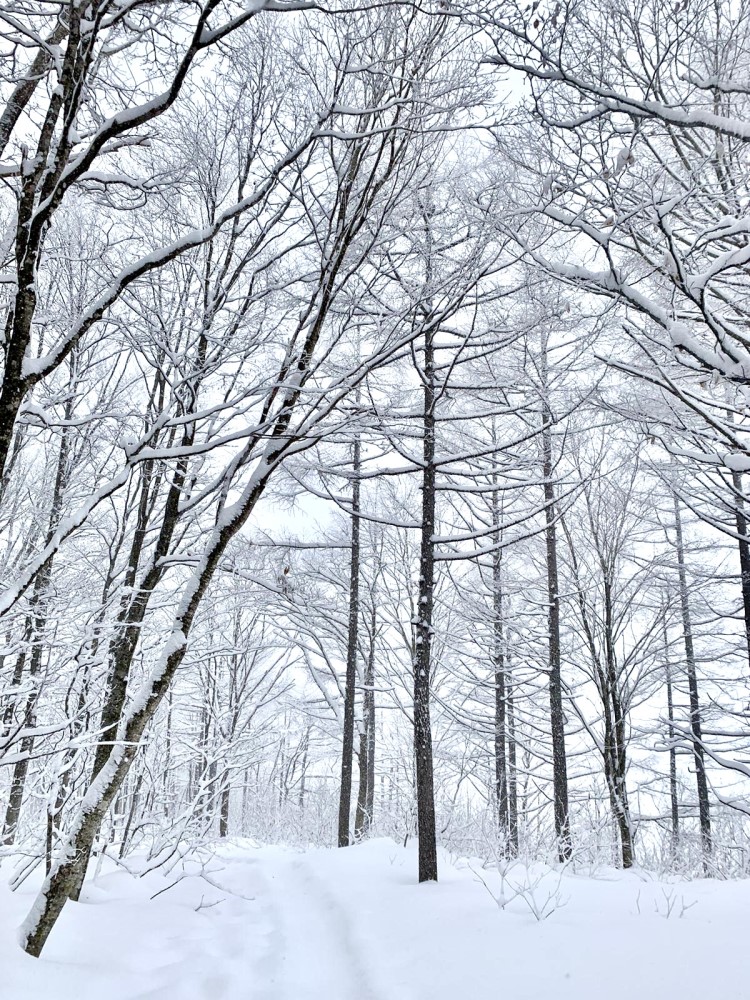


Hakuba Happo-One Snow Resort area
There are several good snowshoe trails near the Matsu River near the Hakuba Happo-One Snow Resort. One of them is the forest trail I walked, which was easy, wide and almost completely flat.
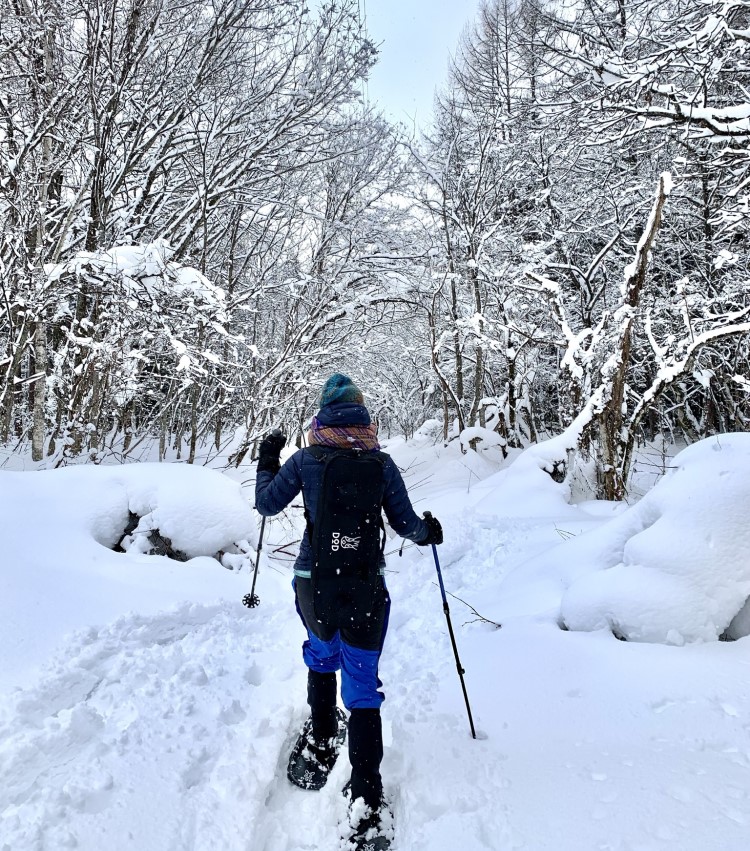

To reach the beginning of the trail from Hakuba Happo Bus Terminal, just follow directions for the Wadano Gateway and Nagano 1998 Memorial.

Next, after passing “Hotel Keyaki no Ki”, continue on Route 322 (Mt. Shirouma Line Road). The trail is on the left side of the road, marked with a yellow NO.6 sign. You can see it on the Maps.Me application as well.



Snowshoe trails in Norikura Kogen
Spectacular frozen waterfalls are the main highlights of Norikura Kogen. The trails turned out to be a bit more difficult, but at the same, more interesting than those in the Hakuba Valley. Overall, Norikura Kogen is a fantastic place for intedependent snowshoeing in Japan!
Zengoro Falls
The Zengoro Waterfall trail is very popular in winter as the frozen waterfall is simply stunning. This is probably the most magical snowy scenery I have ever seen. In addition, it only takes 5 minutes from the tiny center of Norikura Kogen to reach the start of the trail, which is very convenient. Besides, you only need 30 minutes to reach the waterfall, so it is also very easy.
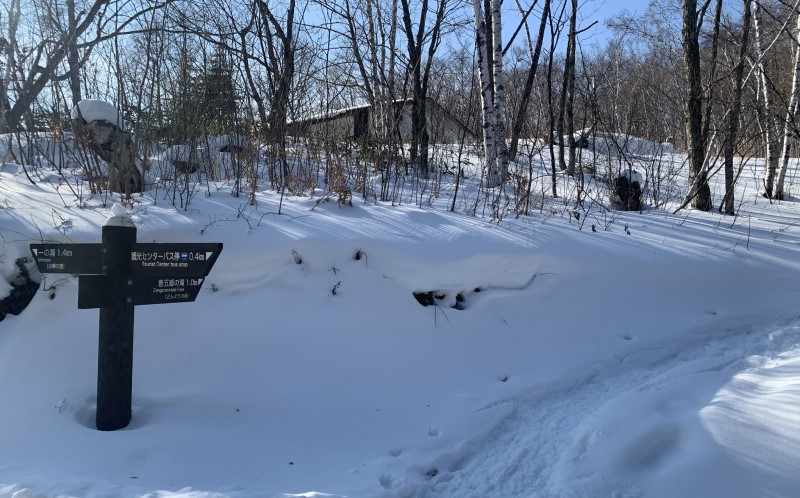



And if you are up for a longer hike, you can do Norikura Kogen – Zengoro Falls – Ushidome Pond – Azami Pond – Ichinose – Norikura Kogen loop that I did and recommend. Just do not expect blue water ponds as they will most likely be frozen and covered with snow as well. The trail is very interesting, wide and always clearly visible. There are many signposts along the way with directions and distances. In addition, the route is marked in the Maps.Me application.
This is by far my favourite trail for independent snowshoeing in Japan. Zengoro Waterfall in winter is simply stunning and the blue sky made the whole experience even more beautiful. It took me almost 5 hours to complete the loop but I did it at a very slow pace.



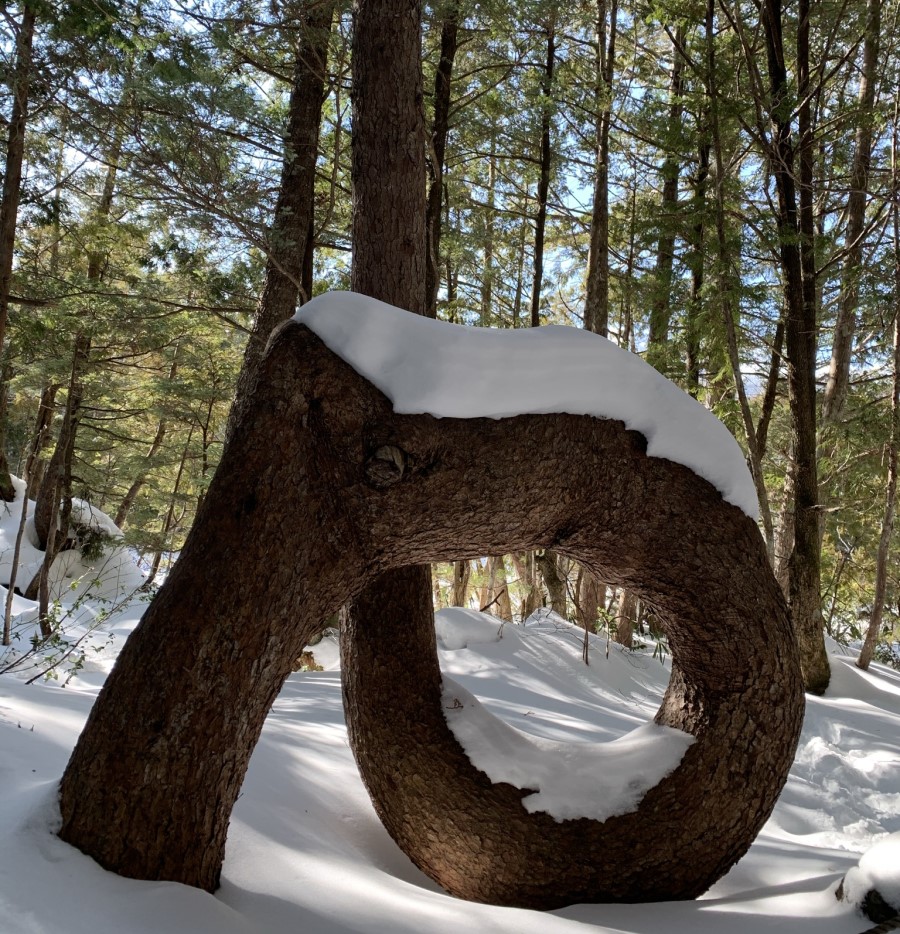


Sanbondaki Falls
The Sanbondaki Falls trail is another very scenic route leading to a spectacular waterfall. Although it is more difficult to get to its beginning, it is really worth it! The trail starts behind Sanbondaki Rest House, which is very easy to reach in summer as there is a bus stop right in front. In winter, the situation becomes a bit more complicated as the road is closed and the area turns into a ski slope. It is unbelievable how the surrounding scenery changes with the seasons.
But nothing is impossible. You just need to reach Mount Norikura Ski Resort to the ski lift. Non-skiers can take it to go uphill but not downhill. So to descend, you will have to walk down the ski slope. This is not a problem though, a lot of people do it with snowshoes, it’s easy and fun.
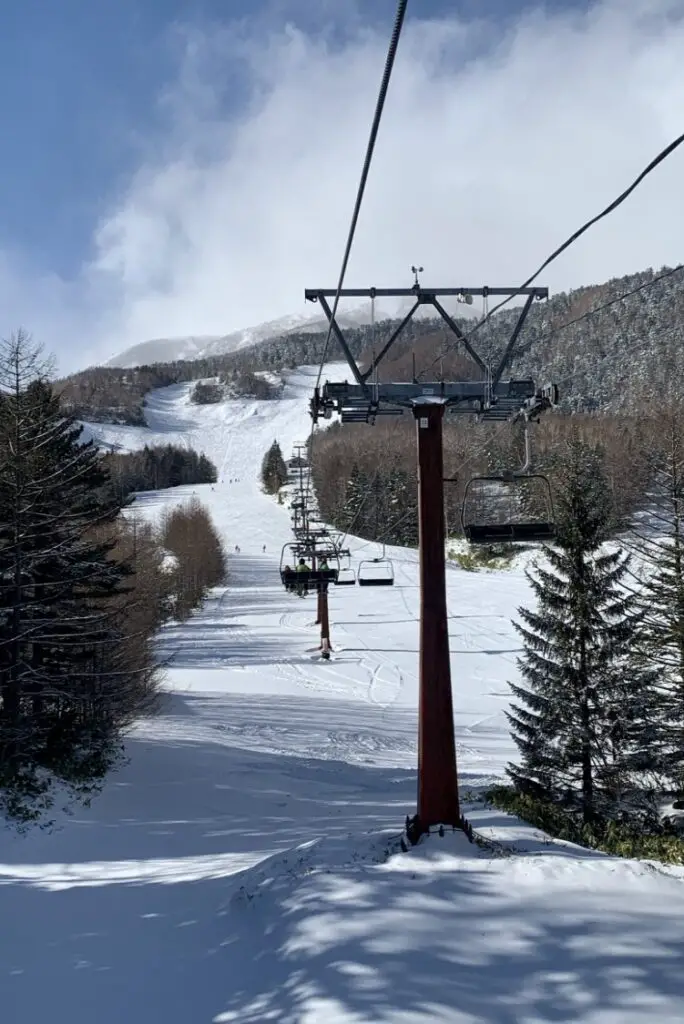

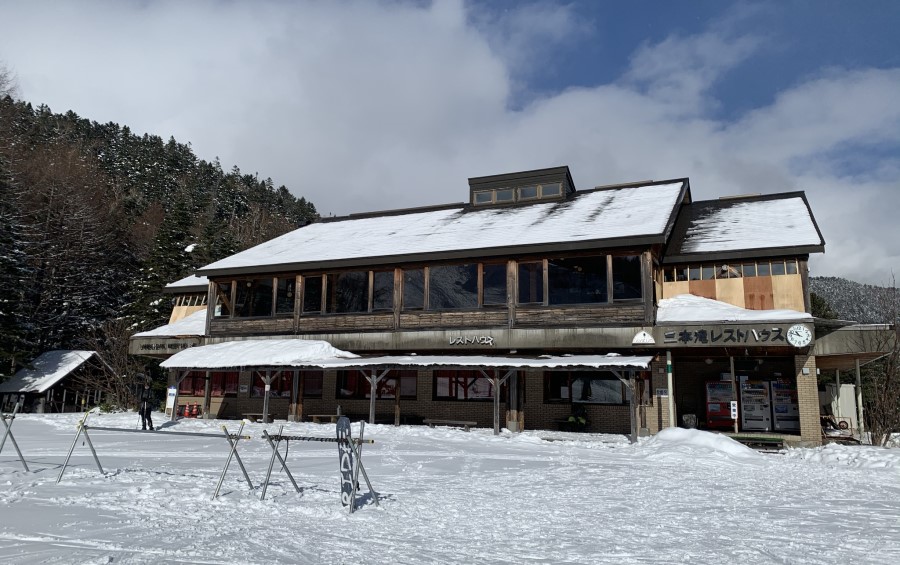





The alternative trail that takes you from Sanbondaki Falls down through the forest rather than the ski slope is too steep for snowshoeing. After my unsuccessful attempt, I landed waist deep in snow, I turned back quickly. At dinner, a local snowshoe expert told me that this path in winter is not passable. Well, as always, I had to try the impossible.
Snowshoe trails in Kamikochi Valley
Kamikochi is a very beautiful and popular mountain valley in summer. Don’t worry that it’s closed in winter (from November to April). It only means the lack of access to tourist infrastructure. Hotels, restaurants and gift shops are closed and no buses are available. Entry of private cars is prohibited all year round. To sum up, everything that is unavailable in winter is what you do not really need in the mountains. Nature is still available. The Kamikochi Valley is a great place for independent snowshoeing.
Unfortunately, due to bad weather and limited transport options because of the pandemic, I have not yet managed to reach Kamikochi in winter. But I know it’s only a matter of time. Visiting this beautiful place without the crowds of tourists, as hardly anyone gets here in winter, is too exciting not to try. In the meantime, you can read more about the Kamikochi Valley snowshoeing in THIS great article.
And if you want to read about Kamikochi Valley in summer, have a look at my article “Japanese Alps – 4 trekking itineraries from Kamikochi” [coming soon!].

Organized snowshoeing tours in Nagano prefecture
HAKUBA VALLEY
If you are still not sure about snowshoeing independently you can sign up for one of the tours organized by the Evergreen Outdoor Center in Hakuba. Although I haven’t participated in any of the tours, I have a good feeling about this company. I stopped by this center to ask about snowshoeing trails in the area. I had a chat with a very professional, helpful and friendly man. He did not insist that I should go with his company but explained where I would find good trails. At the end, he reassured me that I shouldn’t worry at all. With my own snowshoes and current great weather conditions, I will have a lot of fun. Great approach! Details of trips organized by the Evergreen Outdoor Center can be found HERE.
NORIKURA KOGEN
You can sign up for the tour organized at NORTHSTAR Alpine Lodge, which I stayed in Norikura Kogen and enjoyed a lot. Check out the details HERE.
Practical tips for independent snowshoeing in Japan
Wear warm clothes
Even when you are constantly moving, it can be cold, especially when there is no sun, it’s snowing and the wind is strong. Therefore, you need to wear warm clothes. Firstly, waterproof pants are a must for the snow. Secondly, gaiters, which prevent snow from entering the boots from above, will protect your feet from getting wet. Thirdly, merino wool clothing will help keep you warm and at the same time remove moisture, which is very important in winter sports. Lastly, a warm jacket, gloves and a beanie are essential.

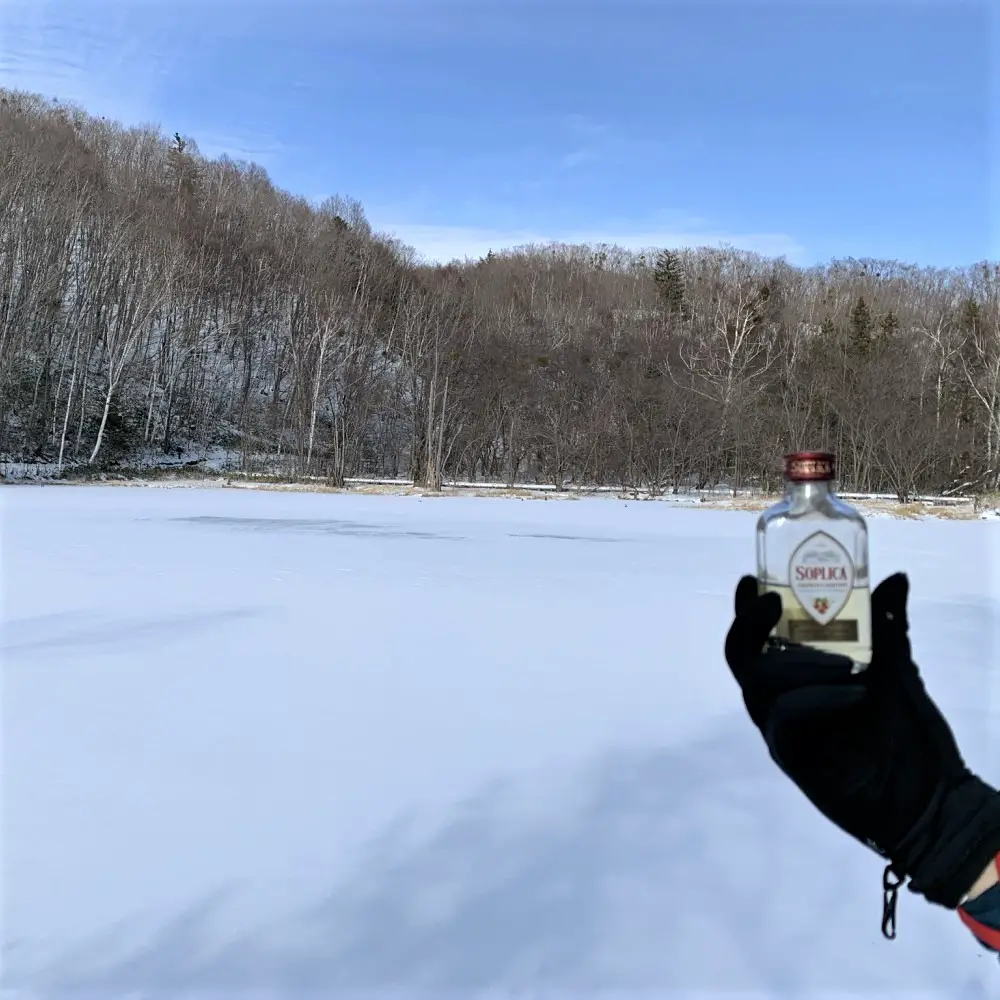
Bring some snacks and hot tea
Any outdoor activity, including independent snowshoeing in Japan, is more fun when you have some snacks. That’s one of the secrets. 🙂 You can bring anything to the mountains, even the least liked snacks that have been lying on your kitchen shelf for months, and you will surely like it. Everything tastes better in the mountains. Overall, life in the mountains is better. Seriously, take some food with you so you will always have enough energy. A small thermos with hot tea to warm you up is a great idea as well.
Bring some snacks and hot tea
Any outdoor activity, including independent snowshoeing in Japan, is more fun when you have some snacks. That’s one of the secrets. 🙂 You can bring anything to the mountains, even the least liked snacks that have been lying on your kitchen shelf for months, and you will surely like it. Everything tastes better in the mountains. Overall, life in the mountains is better. Seriously, take some food with you so you will always have enough energy. A small thermos with hot tea to warm you up is a great idea as well.

Download an offline map -maps.me
I always use Maps.Me, a free offline navigation app, which works great if there is no signal. Just remember to download the Nagano Prefecture maps before your trip. All the trails described in this article are very well marked on Maps.Me, which will prevent you from getting lost or ending up in a snow-covered lake or river. But don’t worry about getting lost too much. When it’s snowy, it’s really hard to get lost, you can always track your footsteps back.


Remember about the snowshoe poles
They help keep your balance when walking in snow. You can transform your regular summer trekking poles into snowshoe poles by purchasing special snow baskets that prevent the poles from digging deep into the snow.
Remember about the snowshoe poles
They help keep your balance when walking in snow. You can transform your regular summer trekking poles into snowshoe poles by purchasing special snow baskets that prevent the poles from digging deep into the snow.

Bring microspikes just in case
Depending on the amount of snow and temperature, on the icy sections of the trail, microspikes can be more useful than snowshoes. They take up little space in a backpack, they are light and cheap, so it’s worth bringing them with you.

How to get to Hakuba Valley and Norikura Kogen from Tokyo?
3-hour journey to HAKUBA VALLEY
- Tokyo Station – Nagano: 90 min by shinkansen;
- Nagano – Hakuba: 70 min by express bus.
In addition, there are two other convenient options from Shinjuku Station:
- Direct JR train (Azusa Limited Express, 3h 40min);
- Alpico bus (5h).
4-hour journey to NORIKURA KOGEN
- Tokyo Station – Nagano: 90 min by shinkansen:
- Nagano – Matsumoto: 50 min by train (JR Line);
- Matsumoto – Shinshimashima: 30 min by train (Kamikochi Line);
- Shinshimashima – Norikura Kogen 45 min by Alpico bus (one ticket for both legs of the journey from Matsumoto).
Where to stay if you plan independent snowshoeing?
Hakuba Highland Hotel (HAKUBA VALLEY)

Even though Hakuba Highland Hotel (HHH) is located quite far from all of Hakuba’s attractions and ski resorts, free hotel shuttles make getting to Iwatake Snow Field and Hakuba Happo Bus Terminal very easy. I chose Hakuba Highland Hotel because of the amazing outdoor onsen with a fantastic mountain view. It was definitely worth it. I don’t normally like buffet dinners, but the hotel’s selection is simply great. It was perfect for Christmas. See hotel details HERE.


NORTHSTAR Alpine Lodge (NORIKURA KOGEN)
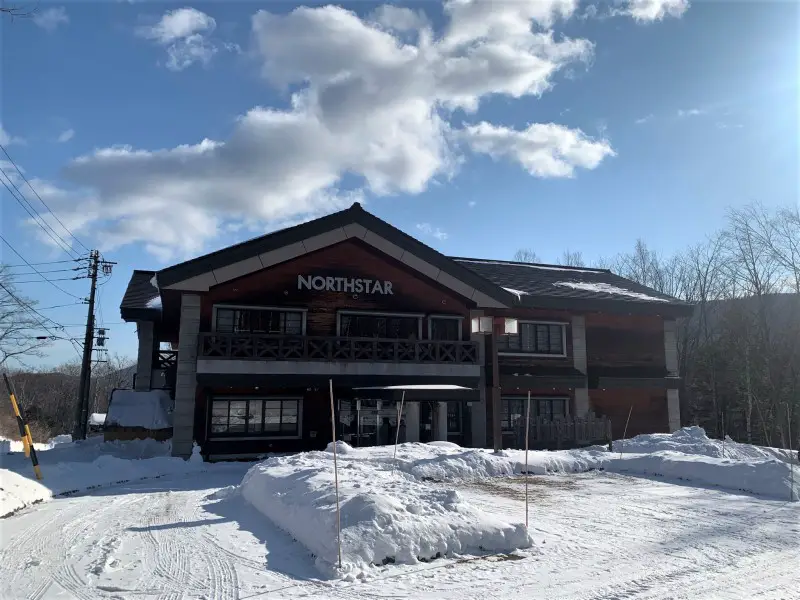
Japanese-style rooms are clean and spacious. The common space decor is amazing, especially if, like me, you love all kinds of outdoor activities. Antique skis and trekking gear are hung on the walls while cool bicycles are displayed on the second floor. The food is fantastic. Staff is friendly, speaks English and will do their best to make you happy. What else do you need? You can check the hotel details HERE.


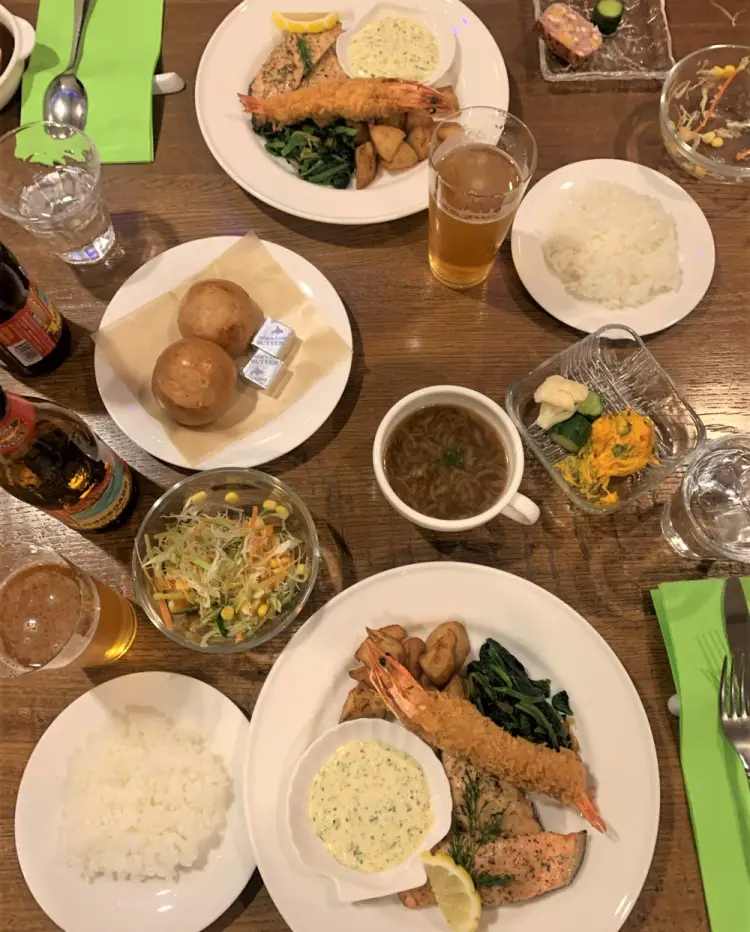
Trails in the Hakuba Valley, easily accessible from Tokyo, or rather those leading to beautiful waterfalls in Norikura Kogen? Or maybe the popular Kamikochi Valley without the usual summer crowds? Let me know what you like the most as I really hope I’ve inspired you to try independent snowshoeing in Japan.
I plan to go for independent snowshoeing again and discover more winter trails in Japan. This is definitely not the end of my snow adventures, but only their beginning. Hopefully this article will grow more and more over time. 🙂





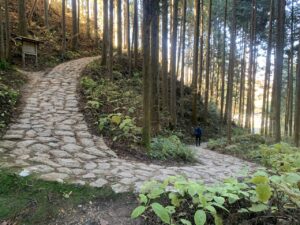

Great fun, so much snow!!! Loved our first snowshoeing adventure!!! Can’t wait to go back again!
Hopefully this year! We still have some time before the snow melts. 🙂
Well done! Thanks for sharing your trips.
Thanks you! I hope someone will find it useful and set off for their snow adventure. 🙂
This website is amazing!!! Thought we were stuck doing a guided tour for our honeymoon this christmas in hakube, but this looks way more fun. Thank you so much for putting this into together.
Thank you Sean. I’m happy you like it and found it useful! What an amazing idea for the honeymoon trip! I wish you happy and safe snow adventures and congratulations! 🙂
Thankyou for detailed info on these trails. Excited to visit in Jan 2024
Hi Anna, thank you for reading! I’m glad you found it useful. Oh, I’m sure it’s going to be great – blue crispy sky, lots of snow, not too many tourists and warm futon, kotatsu or sake. Or all of them! 🙂 Enjoy your planning!
Great information thanks. Looks and sounds like fun.
Planning a family trip for skiing to Akakura Onsen Jan 25. Will look into
Some of the trails you suggest for snow shoeing too. What is the best way to get from Nagano to Zengoro Falls, looking at hiring a car but it says the Nagano Prefectural eye 84 closes over winter months. Any info would be helpful. Thanks
Hi Lisa,
Thank you for your kind feedback! It’s always great to hear that someone finds my posts useful. As for transportation, I traveled from Nagano Station by train to Matsumoto, then from Matsumoto to Shinshimashima on another train. Finally, I took a bus from Shinshimashima to the hotel near the falls.
Although it sounds complicated, it really isn’t—believe me! Traveling by public transportation in Japan is very easy, and the waiting times in Matsumoto and Shinshimashima are usually minimal. Just check Google Maps for more detailed information.